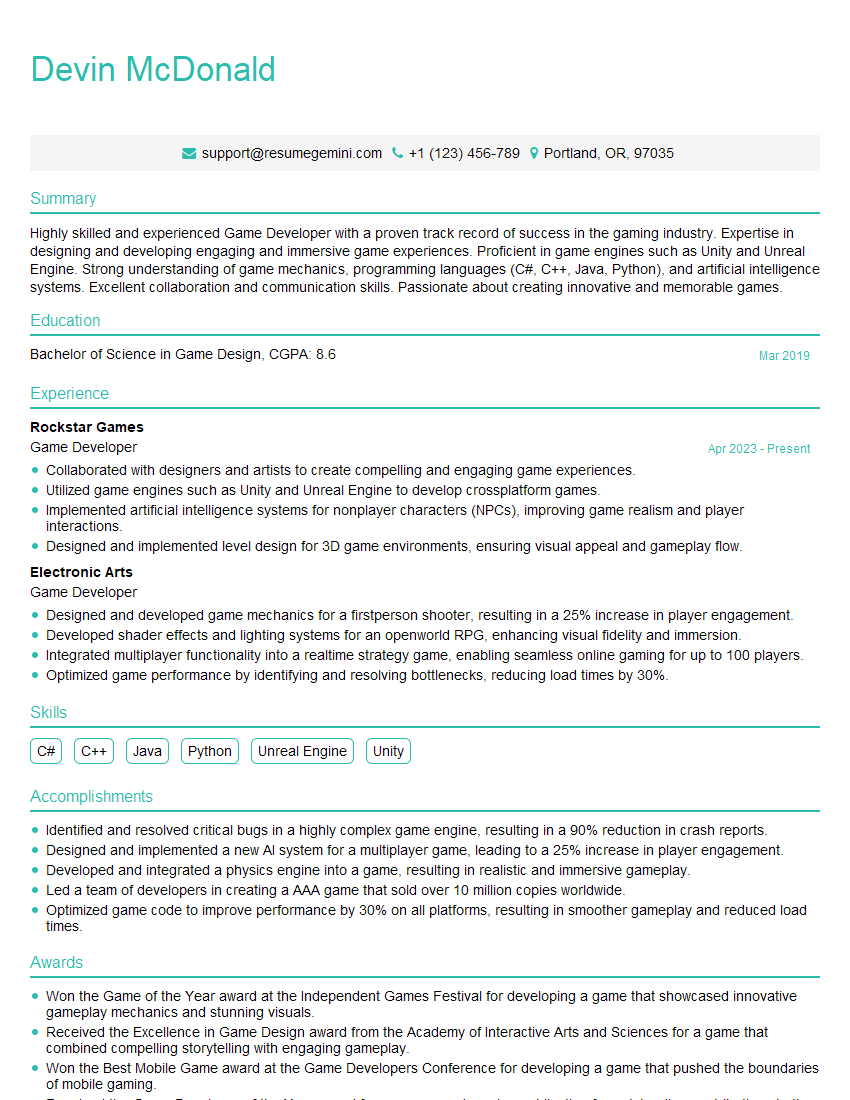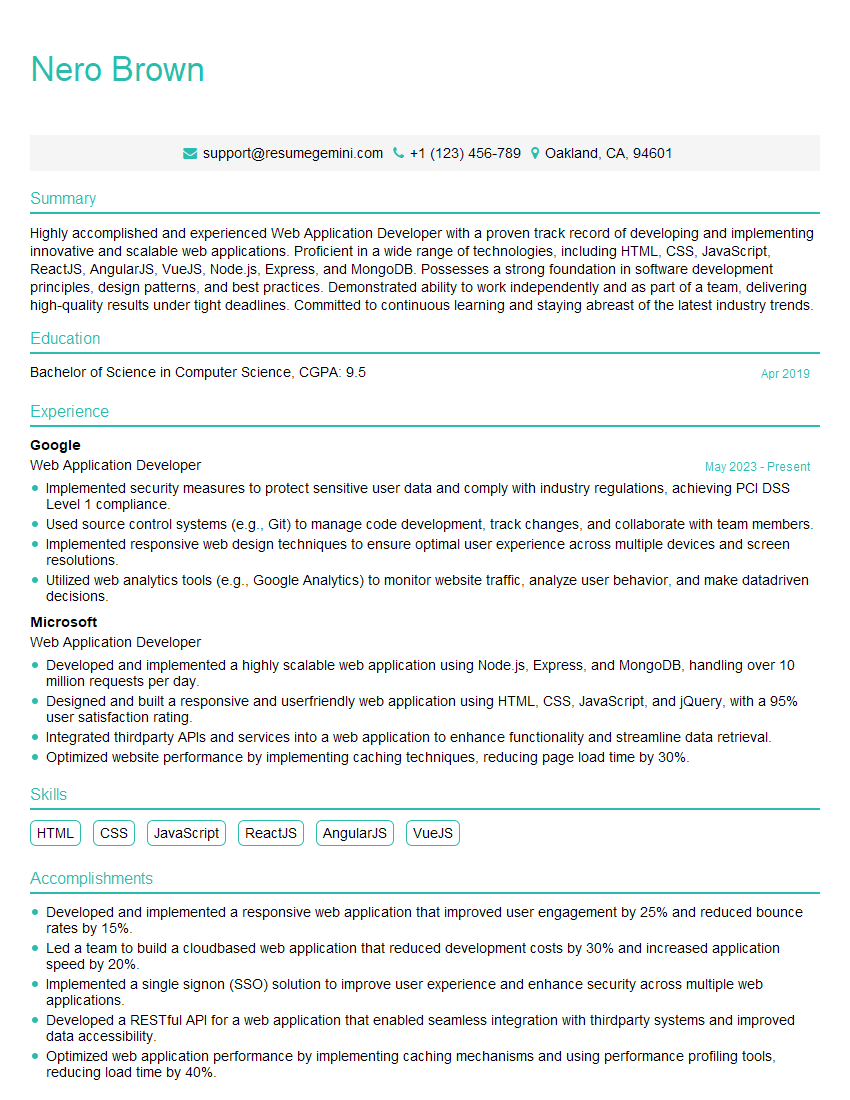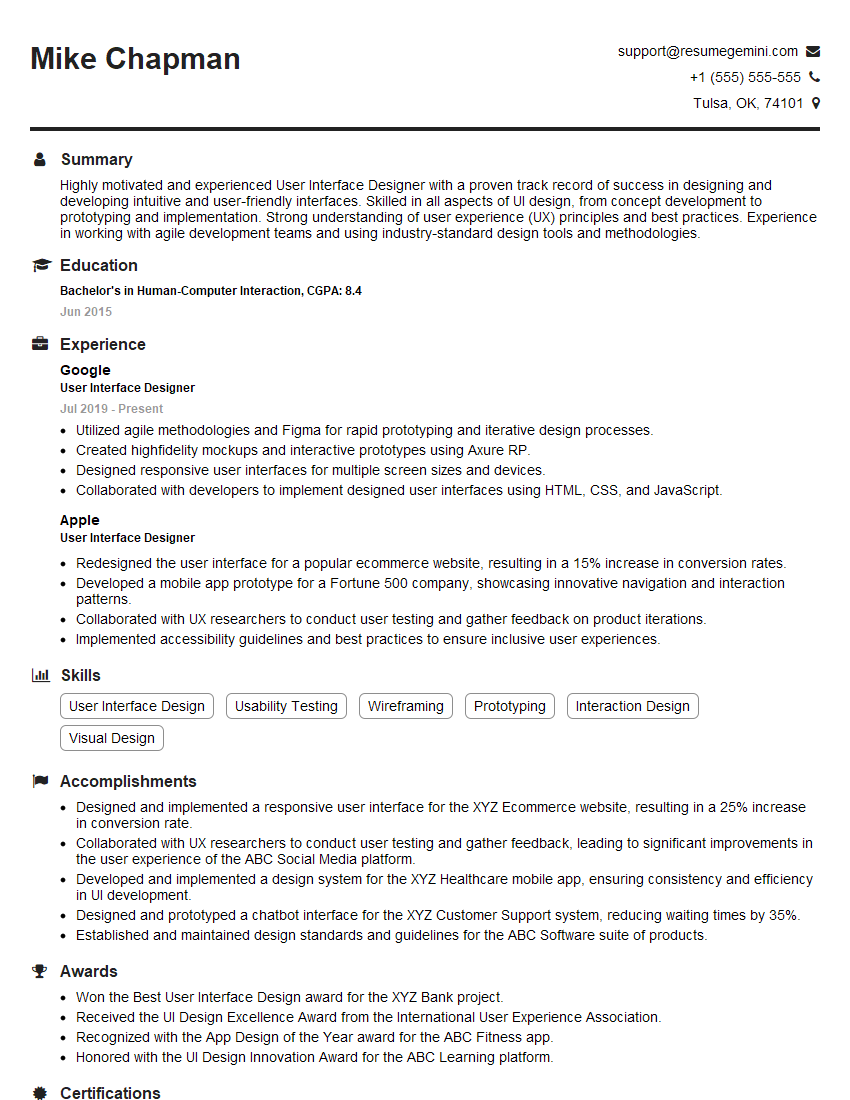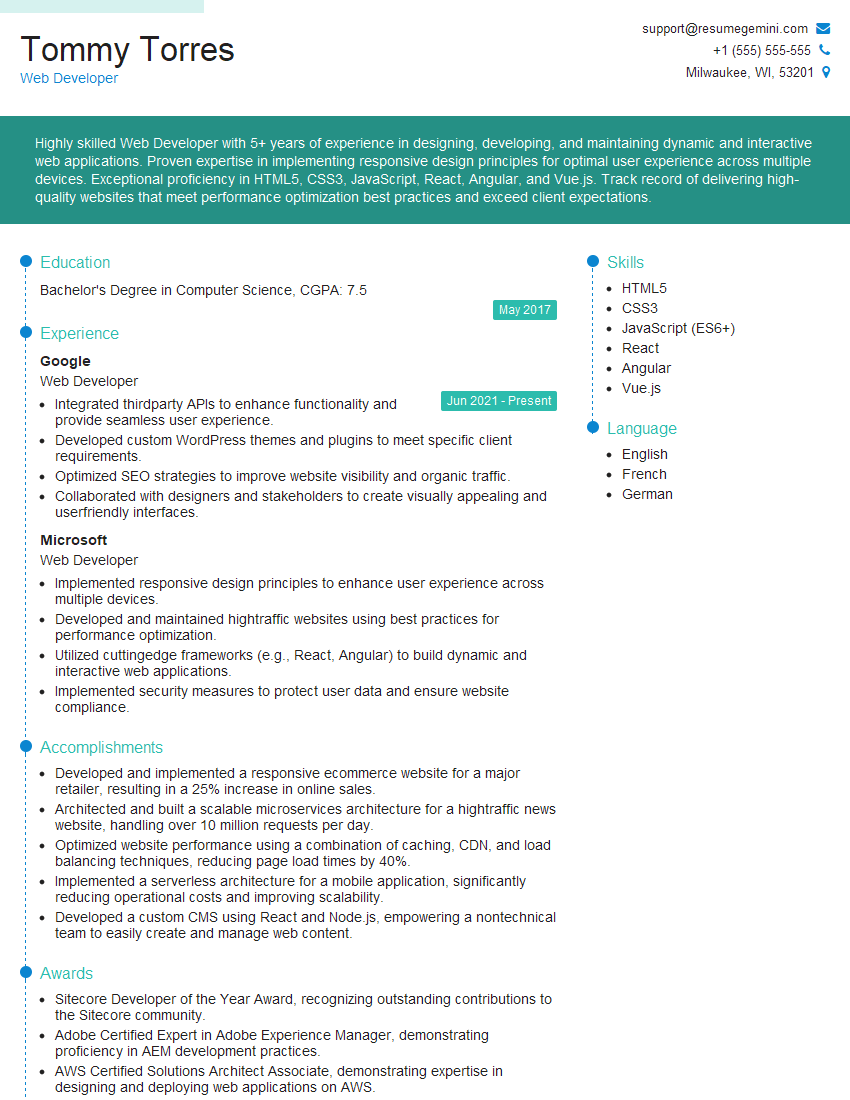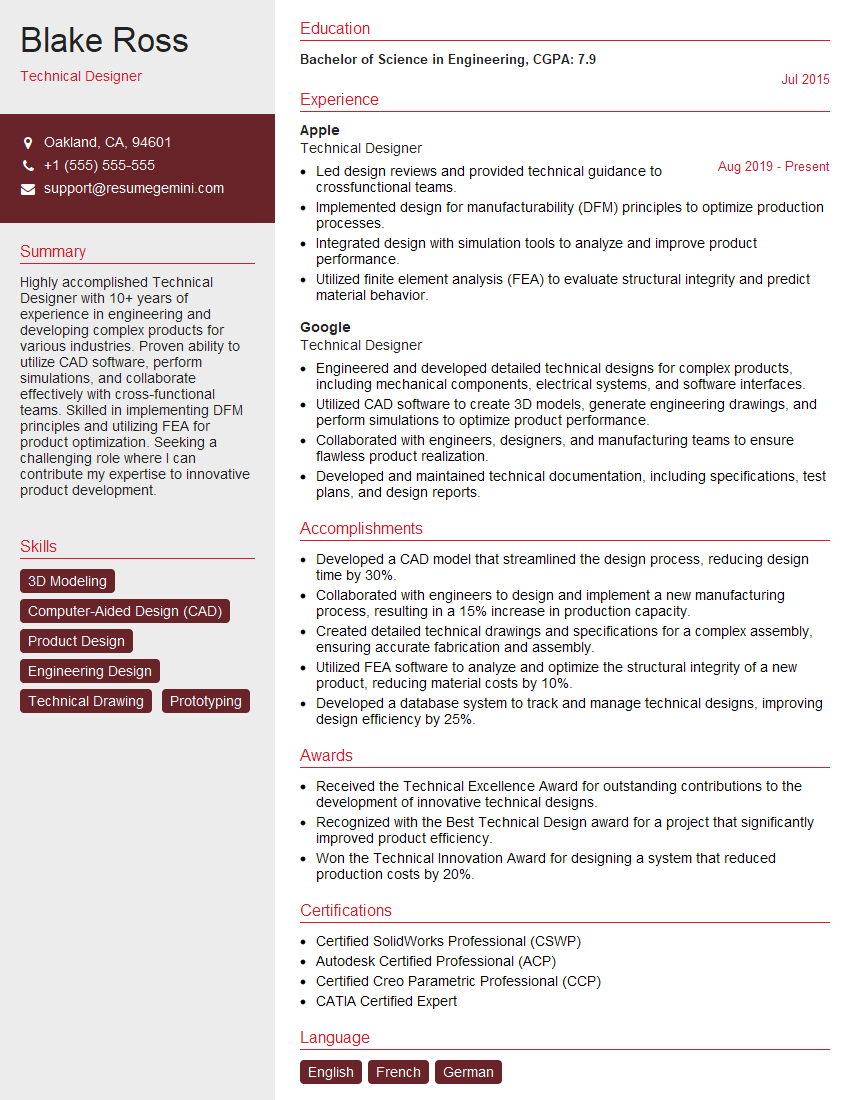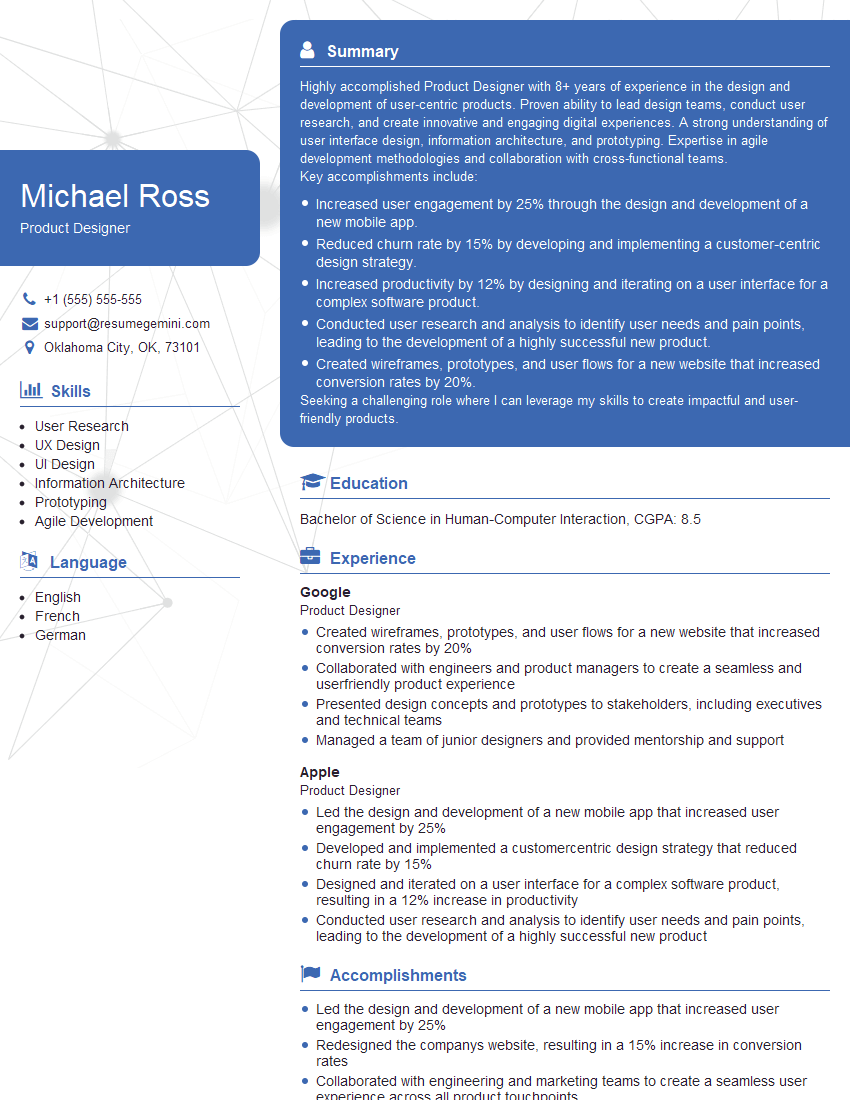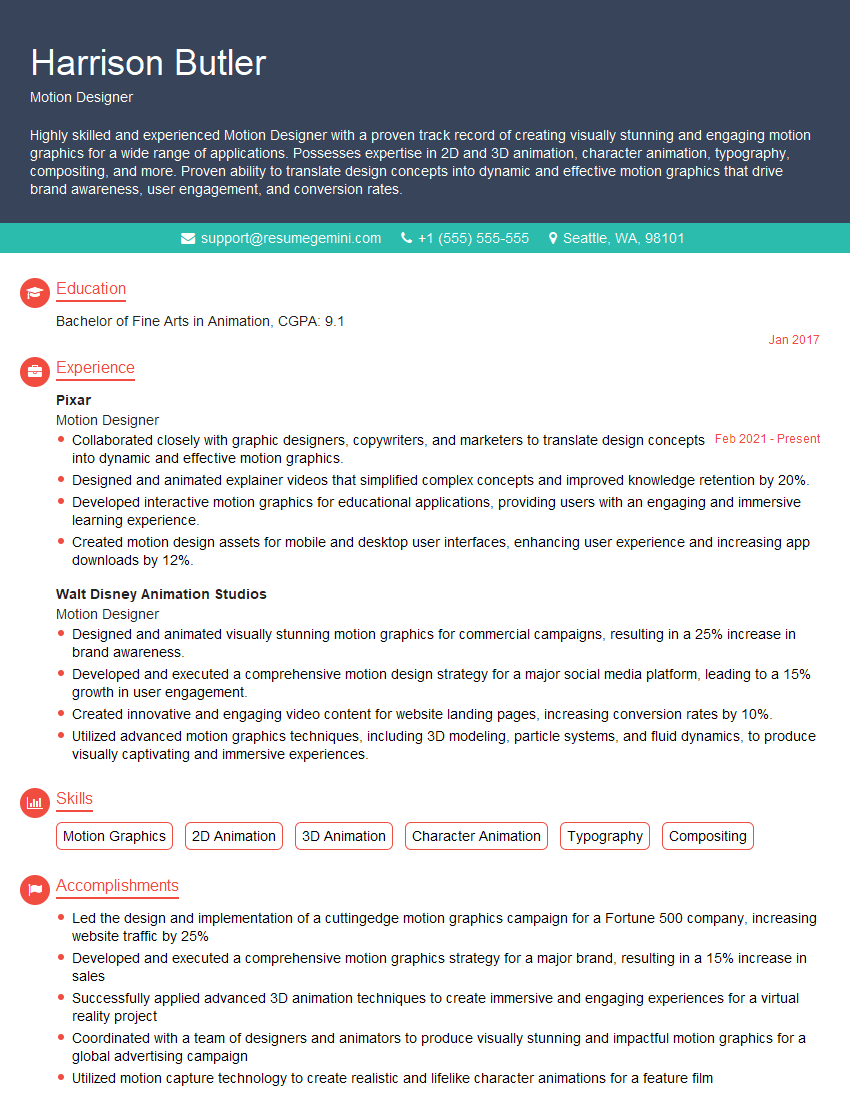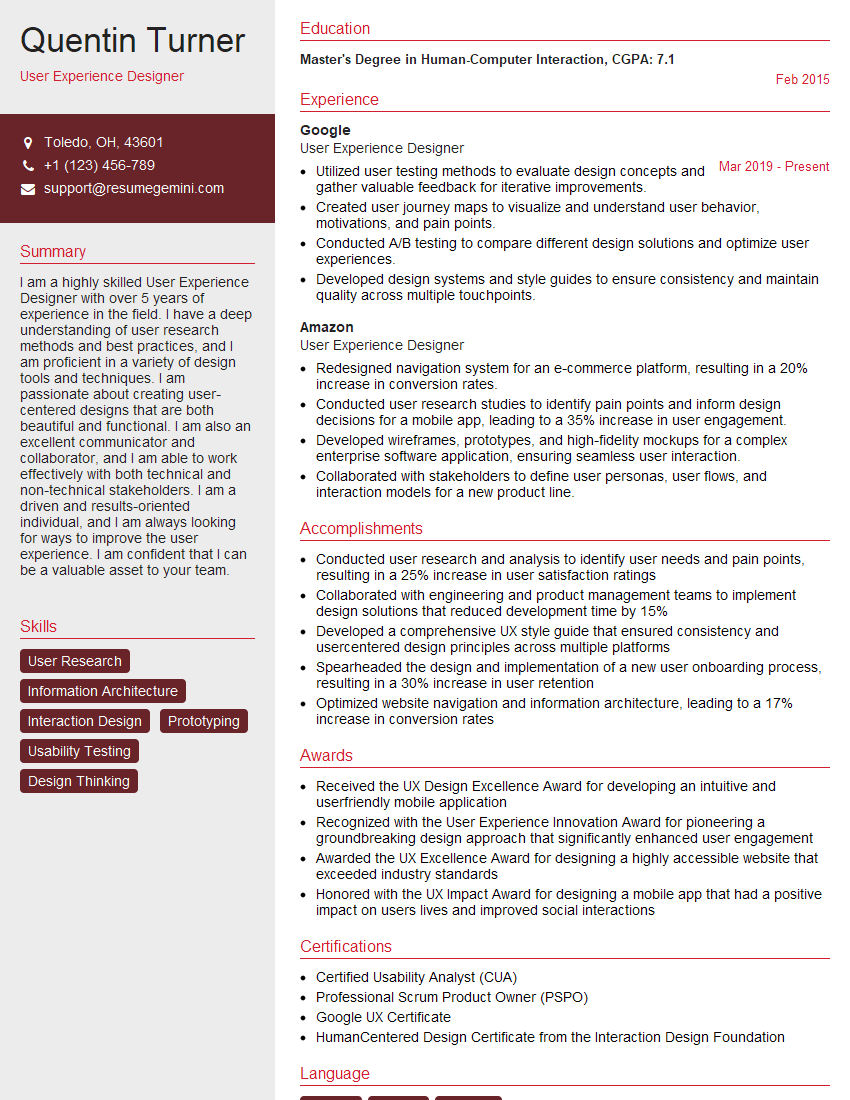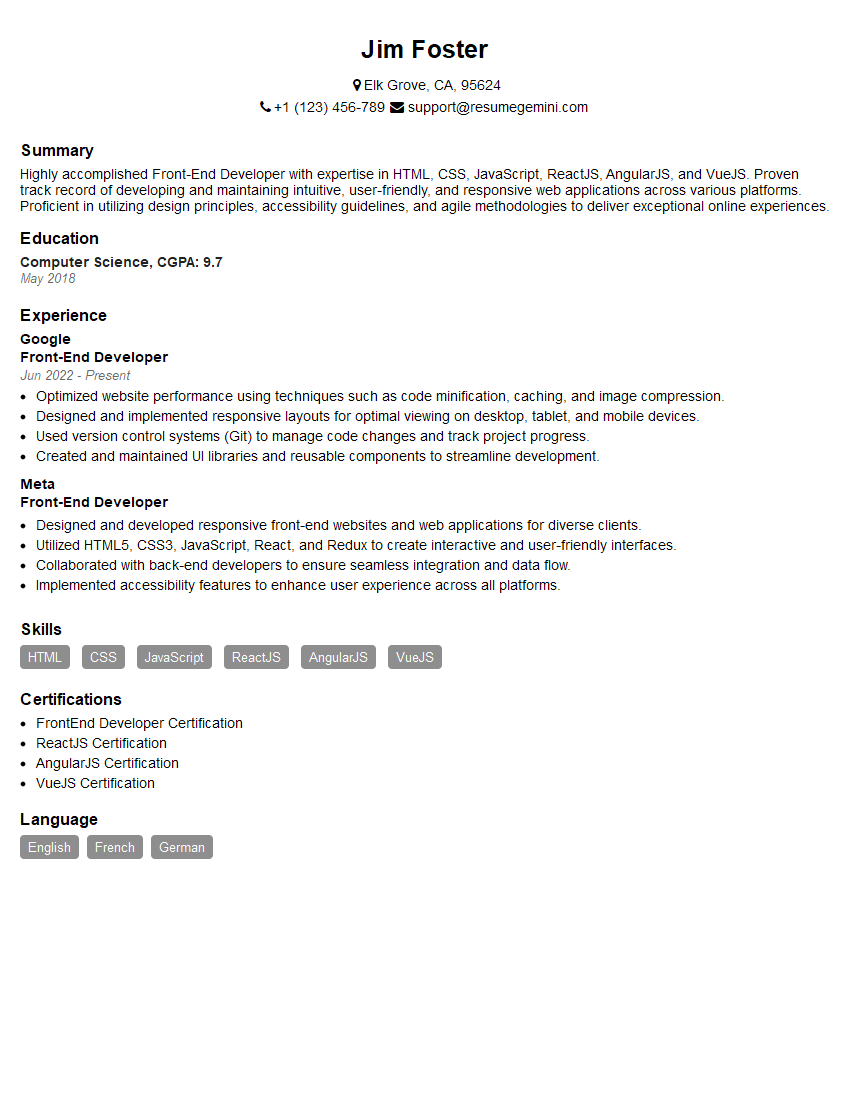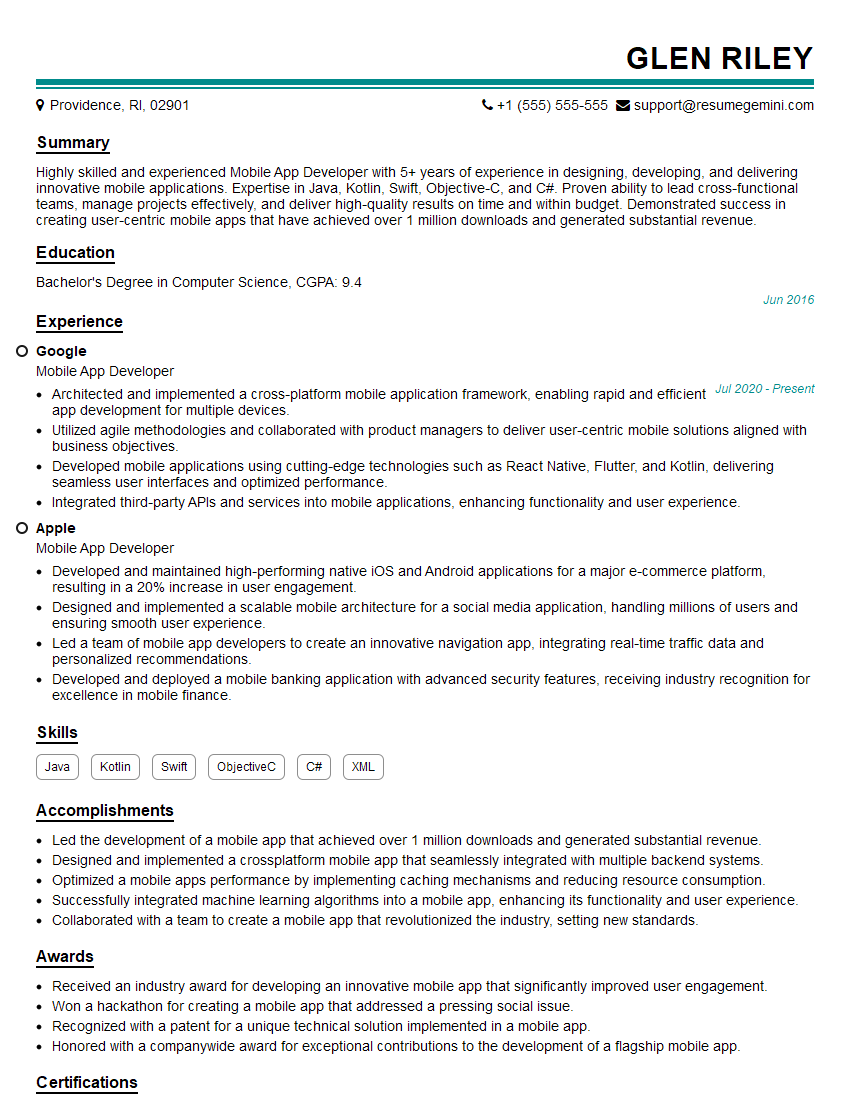Unlock your full potential by mastering the most common Interactive Technologies interview questions. This blog offers a deep dive into the critical topics, ensuring you’re not only prepared to answer but to excel. With these insights, you’ll approach your interview with clarity and confidence.
Questions Asked in Interactive Technologies Interview
Q 1. Explain the difference between UX and UI design.
UX (User Experience) and UI (User Interface) design are closely related but distinct disciplines. Think of UX as the overall feeling a user has when interacting with a product, encompassing everything from ease of use to emotional response. UI, on the other hand, focuses specifically on the visual aspects – the look and feel – of the interaction. UX is the what and why behind the design, considering user needs and goals. UI is the how – the tangible elements users interact with.
For example, imagine designing a mobile banking app. UX would involve researching user needs (easy money transfers, secure login, clear account summaries), defining user flows (steps to complete a transaction), and creating user personas (representing typical users). UI would then translate these findings into the app’s visual elements: buttons, menus, fonts, colors, and overall layout, ensuring they are intuitive and visually appealing.
- UX: Focuses on strategy, user research, information architecture, interaction design, usability, and user testing.
- UI: Focuses on visual design, branding, typography, layout, color palettes, and visual hierarchy.
Q 2. Describe your experience with Agile development methodologies.
I have extensive experience with Agile methodologies, specifically Scrum and Kanban. In previous roles, I’ve been a key participant in sprint planning, daily stand-ups, sprint reviews, and retrospectives. I understand the iterative nature of Agile and its emphasis on collaboration and flexibility. I’m adept at working within short development cycles, adapting to changing requirements, and delivering incremental value to the product.
For instance, on a recent project involving a web application redesign, we utilized Scrum. We broke down the project into manageable sprints (two weeks each), focusing on specific features in each iteration. Daily stand-ups kept everyone informed about progress and potential roadblocks. Sprint reviews allowed us to demonstrate working software to stakeholders and gather feedback, enabling course correction in subsequent sprints. Regular retrospectives helped us identify areas for improvement in our process, contributing to increased team efficiency.
Q 3. What are your preferred design tools and why?
My preferred design tools depend on the project phase and its requirements. For wireframing and prototyping, I frequently use Figma due to its collaborative features and ease of creating interactive prototypes. Its vector-based nature allows for scalable designs. For visual design and UI creation, I utilize Adobe Photoshop and Illustrator for high-fidelity mockups. Their extensive toolsets allow for precise control over visual details.
Additionally, I leverage tools like Sketch (particularly effective for mobile app design) and InVision for advanced prototyping and collaboration. The choice ultimately depends on project needs and team preferences, but I always prioritize tools that promote collaboration and efficient workflows.
Q 4. How do you conduct user research?
User research is crucial for understanding user needs and creating effective designs. My approach is multifaceted and usually begins with defining clear research objectives. This is followed by choosing appropriate research methods. These methods can include:
- User interviews: One-on-one conversations to gather in-depth insights into user behavior and attitudes.
- Surveys: Collecting quantitative and qualitative data from a larger sample size.
- Usability testing: Observing users interacting with prototypes or existing products to identify usability issues.
- A/B testing: Comparing different design variations to determine which performs better.
- Competitive analysis: Analyzing competitors’ products to identify best practices and areas for differentiation.
I meticulously analyze the collected data, drawing meaningful conclusions that inform design decisions. For example, if usability testing reveals difficulty in navigating a specific feature, I would redesign that aspect based on the observed user behavior.
Q 5. Explain your process for creating wireframes and prototypes.
My wireframing and prototyping process is iterative. I begin by sketching low-fidelity wireframes to quickly visualize the structure and layout of the interface. These are often hand-drawn or created using basic wireframing tools. This initial phase is crucial for exploring different design options and identifying potential usability problems early on.
Next, I create mid-fidelity wireframes using tools like Figma, adding more detail to the layout, including basic visual elements. Following that, I develop high-fidelity prototypes in Figma, focusing on the visual aspects and adding interactive elements to simulate real-world usage. This allows for thorough usability testing, gaining insights into user interaction before development begins.
For instance, when designing an e-commerce checkout process, I’d begin with basic wireframes showing the steps involved. The mid-fidelity stage would include the placement of buttons, input fields, and basic visual styles. Finally, the high-fidelity prototype would mirror the final look and feel, allowing users to simulate a complete checkout experience.
Q 6. Describe your experience with responsive design.
Responsive design is essential for ensuring optimal user experience across various devices. My approach incorporates several key techniques:
- Fluid grids: Using percentage-based widths instead of fixed pixels to allow content to adapt to different screen sizes.
- Flexible images: Employing images that scale proportionally without distortion.
- Media queries: Using CSS media queries to apply different styles based on screen size, orientation, and device capabilities.
- Mobile-first approach: Starting with a design optimized for mobile devices and then scaling it up for larger screens.
I always test my designs across different devices and screen resolutions to ensure they are responsive and user-friendly across all platforms. In a recent project, we adopted a mobile-first approach, simplifying the design for smaller screens and then progressively enhancing it for tablets and desktops. This ensured that the mobile experience was not compromised by the complexities of larger screen designs.
Q 7. How do you ensure accessibility in your designs?
Accessibility is paramount in my design process. I strive to create inclusive designs that cater to users with disabilities. My approach involves several key considerations:
- WCAG compliance: Adhering to Web Content Accessibility Guidelines (WCAG) to ensure the design meets accessibility standards.
- Alternative text for images: Providing descriptive alternative text for all images to aid users using screen readers.
- Keyboard navigation: Ensuring all interactive elements are accessible via keyboard navigation for users who cannot use a mouse.
- Color contrast: Maintaining sufficient color contrast between text and background to ensure readability for users with visual impairments.
- ARIA attributes: Using ARIA attributes to enhance the accessibility of interactive elements.
For instance, when designing a website’s navigation menu, I would ensure it’s keyboard-accessible, uses sufficient color contrast, and includes descriptive link text. I regularly use accessibility testing tools to identify and rectify any accessibility issues before launch.
Q 8. What is your experience with A/B testing?
A/B testing is a powerful method for improving user experience and conversion rates. It involves creating two or more versions of a webpage, feature, or advertisement (A, B, C, etc.) and showing them to different user segments. By analyzing user behavior and metrics like click-through rates, conversion rates, and time spent on page, we can determine which version performs better. This data-driven approach allows for iterative improvements and informed design decisions.
For example, I once worked on a redesign of an e-commerce product page. We A/B tested two versions: one with a prominent call-to-action button positioned centrally, and another with a less prominent button placed to the side. The results clearly showed that the centrally positioned button led to a significantly higher conversion rate. This allowed us to confidently choose the higher-performing design.
The process usually involves defining a hypothesis, setting up the test, collecting data, and analyzing the results using statistical significance tests to ensure the observed difference isn’t due to chance. Tools like Optimizely or Google Optimize are frequently used to facilitate A/B testing.
Q 9. How do you handle design feedback and criticism?
Handling design feedback is a critical skill. I approach it by actively listening, seeking clarification if needed, and separating constructive criticism from subjective opinions. I find that asking clarifying questions like, ‘Can you elaborate on what you mean by…’ or ‘What specifically about this design element isn’t working for you?’ helps to better understand the feedback and ensure that I address the core concerns.
I believe in a collaborative approach where feedback is seen as an opportunity for improvement. Documenting feedback in a shared space, like a design review tool or project management software, helps to keep track of all suggestions and ensures transparency within the team. I then analyze all the feedback, prioritize it based on impact and feasibility, and incorporate it into the design where appropriate, explaining my design choices and justifications clearly.
It’s important to remember that not all feedback is created equal. Sometimes feedback needs to be filtered or challenged, and strong communication is key to managing expectations and guiding the process constructively. It’s about finding the balance between incorporating valuable insights and upholding design integrity.
Q 10. Describe your experience with version control systems (e.g., Git).
I have extensive experience using Git, the industry-standard version control system. I’m proficient in using various Git commands, including git clone, git add, git commit, git push, git pull, git branch, and git merge. I understand the importance of branching strategies like Gitflow for managing different features and bug fixes concurrently. I’ve used Git in collaborative environments, leveraging features like pull requests and code reviews to ensure code quality and maintainability.
In my previous role, we used Git extensively for managing our front-end and back-end codebases. We followed a Gitflow workflow, allowing developers to work independently on features without disrupting the main codebase. Pull requests allowed for thorough code reviews and discussions, which helped to catch bugs early and improve code quality. I’m also familiar with using Git platforms like GitHub and Bitbucket for collaborative code management and project tracking.
Understanding Git is crucial for effective teamwork and for managing the evolution of a project over time. It ensures that every change is tracked, allowing for easy rollback to previous versions if needed. Furthermore, Git’s branching capabilities promote collaborative and parallel development.
Q 11. What are some common usability heuristics?
Usability heuristics are general principles that guide the design of user-friendly interfaces. Jakob Nielsen’s 10 usability heuristics are widely recognized. These include:
- Visibility of system status: The system should always keep users informed about what is going on, through appropriate feedback within reasonable time.
- Match between system and the real world: The system should speak the users’ language, with words, phrases and concepts familiar to the user, rather than system-oriented terms.
- User control and freedom: Users often choose system functions by mistake and will need a clearly marked “emergency exit” to leave the unwanted state without having to go through an extended dialogue.
- Consistency and standards: Users should not have to wonder whether different words, situations, or actions mean the same thing.
- Error prevention: Even better than good error messages is a careful design which prevents a problem from occurring in the first place.
- Recognition rather than recall: Minimize the user’s memory load by making objects, actions, and options visible. The user should not have to remember information from one part of the dialogue to another. Instructions for use of the system should be visible or easily retrievable whenever appropriate.
- Flexibility and efficiency of use: Accelerators — unseen by the novice user — may often speed up the interaction for the expert user such that the system can cater to both inexperienced and experienced users.
- Aesthetic and minimalist design: Dialogues should not contain information which is irrelevant or rarely needed. Every extra unit of information in a dialogue competes with the relevant units of information and diminishes their relative visibility.
- Help users recognize, diagnose, and recover from errors: Error messages should be expressed in plain language (no codes), precisely indicate the problem, and constructively suggest a solution.
- Help and documentation: Even though it is better if the system can be used without documentation, it may be necessary to provide help and documentation. Any such information should be easy to search, focused on the user’s task, and list concrete steps to be carried out.
Applying these heuristics helps create intuitive and efficient interfaces that enhance user satisfaction and task completion.
Q 12. Explain your understanding of design systems.
A design system is a collection of reusable components, guidelines, and documentation that helps create a consistent and efficient design process. It’s essentially a single source of truth for all design and development elements within an organization. It typically includes UI components (buttons, forms, typography), design tokens (colors, spacing, typography styles), and design principles that guide the overall aesthetic and user experience.
Think of it as a style guide on steroids. A design system ensures consistency across all platforms and products, reducing development time and improving user experience. It promotes a shared understanding and collaboration between designers and developers, allowing for faster iteration and more predictable outcomes.
The benefits of a design system include improved design consistency, faster development cycles, reduced design debt, and a more predictable and enjoyable user experience. A well-maintained design system acts as a living document that evolves with the organization’s needs, ensuring long-term design and development efficiency.
Q 13. What are your preferred JavaScript frameworks (React, Angular, Vue)?
My preferred JavaScript frameworks are React and Vue. I find that both offer excellent tools for building dynamic and interactive user interfaces. React’s component-based architecture and virtual DOM make it efficient for managing complex applications and building reusable UI components. The large community and extensive ecosystem surrounding React make it a robust choice for large-scale projects.
Vue, on the other hand, often boasts a gentler learning curve and is particularly well-suited for smaller to medium-sized projects. Its progressive adoption approach allows you to integrate it gradually into existing projects. Its excellent documentation and simple syntax also contribute to its popularity.
While I’m proficient in both, my choice would depend on the specific project requirements. For larger, more complex projects with a larger team, React’s robust ecosystem and community support might be more beneficial. For smaller, more agile projects, Vue’s ease of use and simplicity might be a better fit. Ultimately, the best framework depends on the project’s specific needs and team expertise.
Q 14. Explain the concept of progressive web apps (PWAs).
Progressive Web Apps (PWAs) are websites that use modern web capabilities to deliver an app-like experience to users. They bridge the gap between traditional websites and native mobile applications, offering the best of both worlds. PWAs are accessible through a web browser, just like a website, but they can offer features typically found in native apps, such as push notifications, offline functionality, and installability to the home screen.
This is achieved through technologies like service workers, which allow for offline functionality and push notifications, and manifest.json, which enables installability and provides app-like metadata. A well-designed PWA can provide a fast, reliable, and engaging experience to users, regardless of their network connection.
A key advantage of PWAs is that they are easily accessible across multiple platforms (desktop, mobile) without requiring users to download separate apps from app stores. This makes them highly cost-effective to develop and maintain compared to native apps. Examples include Twitter Lite and Forbes, both of which offer improved performance and offline capabilities thanks to their PWA implementation.
Q 15. How familiar are you with HTML5, CSS3, and JavaScript?
HTML5, CSS3, and JavaScript form the core trinity of front-end web development. My familiarity extends beyond basic usage; I possess advanced skills in all three.
HTML5 provides the structural foundation of web pages, defining elements like headings, paragraphs, and images. I’m proficient in semantic HTML5, using elements like <article>, <aside>, and <nav> to create well-structured and accessible websites. I also leverage HTML5 APIs for features like geolocation, local storage, and WebSockets.
CSS3 handles the visual presentation, styling elements with properties like color, font, layout, and responsiveness. I’m experienced with CSS preprocessors like Sass and Less, which boost efficiency and maintainability through features like variables and nesting. I’m adept at creating responsive designs using media queries and flexible layouts, ensuring optimal viewing across various devices.
JavaScript adds interactivity and dynamic behavior. I’m highly proficient in modern JavaScript, including ES6+ features, using frameworks and libraries such as React, Angular, or Vue.js to build complex single-page applications (SPAs) and interactive user interfaces. My experience encompasses asynchronous programming using promises and async/await, and I’m comfortable working with various JavaScript design patterns.
Career Expert Tips:
- Ace those interviews! Prepare effectively by reviewing the Top 50 Most Common Interview Questions on ResumeGemini.
- Navigate your job search with confidence! Explore a wide range of Career Tips on ResumeGemini. Learn about common challenges and recommendations to overcome them.
- Craft the perfect resume! Master the Art of Resume Writing with ResumeGemini’s guide. Showcase your unique qualifications and achievements effectively.
- Don’t miss out on holiday savings! Build your dream resume with ResumeGemini’s ATS optimized templates.
Q 16. Describe your experience with RESTful APIs.
RESTful APIs are the backbone of modern web applications, enabling communication between client-side and server-side components. My experience involves designing, consuming, and testing REST APIs extensively.
I’ve worked with various API design best practices, adhering to HTTP methods (GET, POST, PUT, DELETE) and standard response codes. I’m familiar with API authentication mechanisms like OAuth 2.0 and JWT (JSON Web Tokens). I’ve used tools like Postman for API testing and debugging, ensuring that APIs are efficient, reliable, and well-documented.
For example, in a recent project, I developed a RESTful API to manage user accounts and their associated data. This API handled user registration, login, profile updates, and data retrieval, all using appropriate HTTP methods and status codes. The API was designed to be scalable and maintainable, using a well-defined data structure and employing versioning for future updates.
Q 17. How do you optimize web pages for performance?
Optimizing web pages for performance is crucial for user experience and search engine ranking. My approach involves a multi-faceted strategy targeting various aspects of website loading and execution.
- Minimizing HTTP requests: Combining CSS and JavaScript files, using image sprites, and employing efficient caching mechanisms.
- Image optimization: Compressing images without significant quality loss, using appropriate formats (WebP, for instance), and resizing images to fit their intended use.
- Code minification and compression: Reducing the size of JavaScript and CSS files by removing unnecessary characters and compressing them.
- Lazy loading: Loading images and other content only when they are visible to the user, improving initial page load time.
- Content Delivery Network (CDN): Distributing content across multiple servers to reduce latency for users in different geographical locations.
- Browser caching: Leveraging browser caching mechanisms to reduce the number of requests made to the server.
I use tools like Google PageSpeed Insights and Lighthouse to identify areas for improvement and measure performance gains after optimization.
Q 18. Explain your experience with cross-browser compatibility.
Cross-browser compatibility is a critical concern in web development, ensuring consistent rendering and functionality across different browsers and devices. My experience involves employing several techniques to address this challenge.
- Using CSS resets or normalizers: Establishing a consistent baseline for styling across browsers.
- Testing across multiple browsers and devices: Employing browser developer tools and real device testing to identify and fix browser-specific issues.
- Using feature detection: Employing JavaScript to detect browser capabilities and adapt accordingly, providing fallback mechanisms where necessary.
- Following CSS specification standards: Adhering to W3C standards ensures higher compatibility.
- Employing CSS prefixes: When necessary, using browser-specific prefixes to ensure compatibility for newer CSS properties across older browsers.
For instance, I’ve encountered scenarios where certain CSS properties rendered differently in Internet Explorer compared to Chrome. By using feature detection or appropriate CSS prefixes, I ensure the website renders correctly regardless of the browser used.
Q 19. How do you approach solving complex design problems?
Solving complex design problems requires a structured approach. I typically follow a process that involves:
- Understanding the problem: Defining the problem clearly, identifying user needs, and gathering relevant information.
- Brainstorming and ideation: Generating a wide range of potential solutions using techniques like sketching, mind mapping, and user story mapping.
- Prototyping: Creating low-fidelity prototypes to test and refine ideas quickly and iteratively. This might involve wireframes, mockups, or interactive prototypes.
- Testing and iteration: Conducting usability testing with target users to gather feedback and make necessary adjustments.
- Implementation: Implementing the chosen solution, focusing on accessibility, usability, and performance.
I often employ design thinking principles, focusing on user-centered design to arrive at solutions that are both functional and aesthetically pleasing.
Q 20. Describe your experience with user testing and data analysis.
User testing and data analysis are integral to iterative design and improvement. My experience involves conducting various forms of user testing, including A/B testing, usability testing, and surveys.
I utilize tools like Google Analytics to track website usage, user behavior, and conversion rates. I analyze this data to identify areas for improvement, make data-driven decisions, and measure the impact of design changes. For example, in a recent project, we conducted A/B testing on two different layouts for a product page. By analyzing the data collected, we determined which layout resulted in a higher conversion rate, allowing us to optimize the user experience.
Furthermore, I’m proficient in using qualitative data analysis techniques to interpret user feedback gathered through interviews and usability sessions, helping me identify usability issues and improve the overall design.
Q 21. What is your experience with different interaction models (e.g., touch, voice)?
My experience encompasses various interaction models, understanding that user interaction extends beyond the traditional mouse and keyboard.
Touch interaction: I’m experienced in designing and developing responsive websites and mobile applications that are optimized for touch-based interactions. This includes designing intuitive touch targets, implementing touch gestures, and ensuring smooth scrolling and navigation on touchscreen devices.
Voice interaction: I have experience integrating voice assistants (like Alexa or Google Assistant) into web applications, creating conversational interfaces that provide intuitive voice control. I understand the design principles for effective voice interaction, such as natural language processing and dialogue design.
In essence, I adapt to the specific interaction model required by the project, ensuring a seamless and enjoyable user experience across different platforms and devices. The key is to consider the context and constraints imposed by each interaction model and to design interfaces that are both intuitive and efficient.
Q 22. How do you stay up-to-date with the latest trends in interactive technologies?
Staying current in the rapidly evolving field of interactive technologies requires a multi-pronged approach. It’s not enough to simply rely on one source; a diverse intake is crucial. I actively participate in several key strategies:
Following Industry Publications and Blogs: I regularly read publications like Interaction Design Foundation articles, Awwwards, and UX Collective for insightful articles and case studies on the latest trends and best practices.
Attending Conferences and Workshops: Events like UXPA International Conference and Interaction Design Association conferences offer invaluable opportunities to network with peers, learn from experts, and get a pulse on emerging technologies and design thinking.
Engaging with Online Communities: Platforms like Reddit’s r/UXDesign and online forums allow me to participate in discussions, ask questions, and learn from the collective experience of a vast community of designers and developers. This fosters a continuous learning environment.
Experimenting with New Tools and Technologies: I dedicate time to exploring new prototyping tools, animation software, and development frameworks. Hands-on experience is essential for understanding their capabilities and limitations. This often involves personal projects to solidify my understanding.
Following Key Influencers and Researchers: I actively follow thought leaders and researchers on social media (like Twitter and LinkedIn) and subscribe to their newsletters to stay abreast of their work and insights.
This multifaceted approach ensures I remain adaptable and informed about the ever-changing landscape of interactive technologies.
Q 23. Describe your experience with prototyping tools (e.g., Figma, Adobe XD).
I have extensive experience using various prototyping tools, primarily Figma and Adobe XD. My proficiency extends beyond basic wireframing to encompass interactive prototypes with complex animations and transitions.
Figma: I leverage Figma’s collaborative features extensively, particularly for teamwork on large projects. Its component-based design system allows for efficient design scaling and maintenance. I find its vector editing capabilities and plugin ecosystem particularly powerful, enabling me to integrate with other tools and automate tasks.
Adobe XD: I utilize Adobe XD for its strong integration with other Adobe Creative Suite applications and its robust prototyping capabilities. Its user flows and time-based interactions are helpful for showcasing complex user journeys. I find it particularly well-suited for creating high-fidelity prototypes.
My choice of tool depends on the project’s specific needs and the team’s familiarity with the software. I am equally comfortable guiding clients through the prototype process using either tool, ensuring clear communication and a shared understanding of the design.
Q 24. Explain your understanding of design patterns.
Design patterns are reusable solutions to commonly occurring problems within a specific context in software design and, more broadly, user interface design. They provide a blueprint for solving recurring challenges, promoting consistency, maintainability, and efficiency.
Understanding design patterns in interactive technologies is vital because they guide the creation of user-friendly and predictable interfaces. They avoid reinventing the wheel and ensure that users have a consistent experience across different applications. For instance, the Model-View-Controller (MVC) pattern effectively separates concerns in application development, making maintenance and updates easier. Similarly, patterns like the accordion or tabbed navigation are prevalent in UI design, offering structured ways to present large amounts of information.
In my experience, I’ve successfully used design patterns to streamline the development process, saving time and effort. For example, on a recent e-commerce project, utilizing the shopping cart pattern with well-defined components allowed us to quickly integrate features like adding items, updating quantities, and checking out.
Q 25. How do you handle conflicting priorities in a project?
Handling conflicting priorities requires a structured approach that prioritizes clear communication, collaborative decision-making, and strategic trade-offs.
Clarify Priorities: I begin by working with stakeholders to clearly define and prioritize project goals. This often involves creating a prioritized list of features, ranked by importance and impact.
Assess Trade-offs: When conflicts arise, I analyze the potential impact of each option on the project’s success. This often involves identifying dependencies and potential risks.
Data-Driven Decisions: Where possible, I use data and analytics to inform my decision-making. This allows for a more objective approach, rather than relying solely on intuition.
Negotiate and Compromise: I facilitate open discussions with stakeholders to negotiate and find compromises. This involves explaining the implications of different choices and reaching consensus.
Document Decisions: Once decisions are made, I ensure they are clearly documented and communicated to the entire team, avoiding future confusion.
Ultimately, effective conflict resolution requires strong communication skills and the ability to navigate complex situations while maintaining a focus on the project’s overall objectives.
Q 26. Describe your experience with different design methodologies (e.g., Lean UX).
My experience encompasses various design methodologies, with Lean UX being a particular favorite for its iterative and data-driven approach.
Lean UX: This methodology emphasizes rapid prototyping, iterative development, and continuous user feedback. Its focus on validating assumptions quickly reduces wasted effort on features that may not resonate with users. I’ve used this in several projects, starting with minimal viable products (MVPs) and continuously improving based on user testing and analytics.
Agile: I am well-versed in Agile principles, integrating them seamlessly with Lean UX methodologies. The iterative nature of Agile and its emphasis on collaboration align perfectly with rapid prototyping and user feedback loops.
Design Thinking: The human-centered design process of Design Thinking often informs my approach. It guides me through understanding user needs, ideating solutions, and prototyping and testing those solutions iteratively.
The choice of methodology depends on the project context, timeline, and client needs. My adaptability allows me to select and tailor the most effective approach for each scenario.
Q 27. Explain your understanding of micro-interactions.
Micro-interactions are small, self-contained interactions within a user interface that provide subtle feedback or functionality. They are often overlooked but crucial for enhancing user experience. They add a layer of polish and delight to the interaction, making the application feel more responsive and engaging.
Examples include:
Button hover effects: A subtle change in color or size when a user hovers over a button provides immediate visual feedback.
Loading indicators: A small animation that shows progress during a loading process keeps the user informed and prevents frustration.
Checkboxes and radio buttons: A subtle animation when selected provides visual confirmation of the user’s action.
Well-designed micro-interactions enhance the perceived quality of the application, making it feel more polished and intuitive. They provide a sense of responsiveness and engagement, contributing greatly to a positive user experience. Overuse can become distracting, so careful consideration of their placement and design is necessary.
Q 28. How do you measure the success of an interactive design?
Measuring the success of an interactive design involves a multi-faceted approach that goes beyond simply observing user behavior. A holistic strategy employs both quantitative and qualitative data to paint a complete picture.
Quantitative Metrics: These metrics provide numerical data about user engagement. Examples include:
- Conversion rates: The percentage of users who complete a desired action (e.g., making a purchase).
- Task completion rates: The percentage of users who successfully complete a specific task.
- Bounce rates: The percentage of users who leave the site after viewing only one page.
- Time on task: The average time spent completing a specific task.
Qualitative Metrics: These metrics provide insights into user experience and satisfaction. Examples include:
- User feedback: Gathering user feedback through surveys, interviews, or usability testing.
- Usability testing: Observing users as they interact with the design to identify pain points and areas for improvement.
- A/B testing: Comparing different design variations to determine which performs better.
Combining these quantitative and qualitative metrics allows for a comprehensive understanding of the design’s effectiveness and areas requiring further refinement. The specific metrics chosen depend on the project goals and target audience.
Key Topics to Learn for Interactive Technologies Interview
- User Interface (UI) Design Principles: Understanding UX/UI best practices, including information architecture, interaction design, and visual design. Practical application: Analyzing existing interfaces for usability and suggesting improvements.
- User Experience (UX) Research Methods: Familiarization with user research techniques like usability testing, A/B testing, and user interviews. Practical application: Designing and conducting user research to inform design decisions.
- Front-End Development Technologies: Proficiency in HTML, CSS, and JavaScript, including frameworks like React, Angular, or Vue.js. Practical application: Building interactive prototypes and demonstrating understanding of responsive design.
- Accessibility and Inclusivity: Knowledge of WCAG guidelines and best practices for creating accessible and inclusive interactive experiences. Practical application: Auditing existing interfaces for accessibility issues and proposing solutions.
- Data Visualization and Interaction: Understanding how to effectively present data visually and create interactive data visualizations. Practical application: Creating engaging dashboards and interactive charts.
- Animation and Motion Design: Understanding the principles of animation and how to use motion to enhance user experience. Practical application: Creating micro-interactions and animations to improve feedback and engagement.
- Problem-Solving and Design Thinking: Ability to approach design challenges using a structured problem-solving process and design thinking methodologies. Practical application: Effectively communicating design solutions and justifications.
Next Steps
Mastering Interactive Technologies opens doors to exciting and rewarding careers in a rapidly evolving field. To maximize your job prospects, creating a strong, ATS-friendly resume is crucial. ResumeGemini is a trusted resource that can help you build a professional and impactful resume, highlighting your skills and experience effectively. We provide examples of resumes tailored to Interactive Technologies to guide you in showcasing your qualifications. Take the next step towards your dream career – build your best resume with ResumeGemini today!
Explore more articles
Users Rating of Our Blogs
Share Your Experience
We value your feedback! Please rate our content and share your thoughts (optional).
What Readers Say About Our Blog
Hi, I represent an SEO company that specialises in getting you AI citations and higher rankings on Google. I’d like to offer you a 100% free SEO audit for your website. Would you be interested?
good
